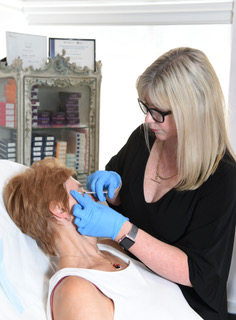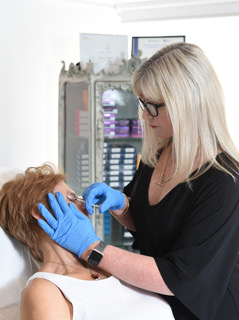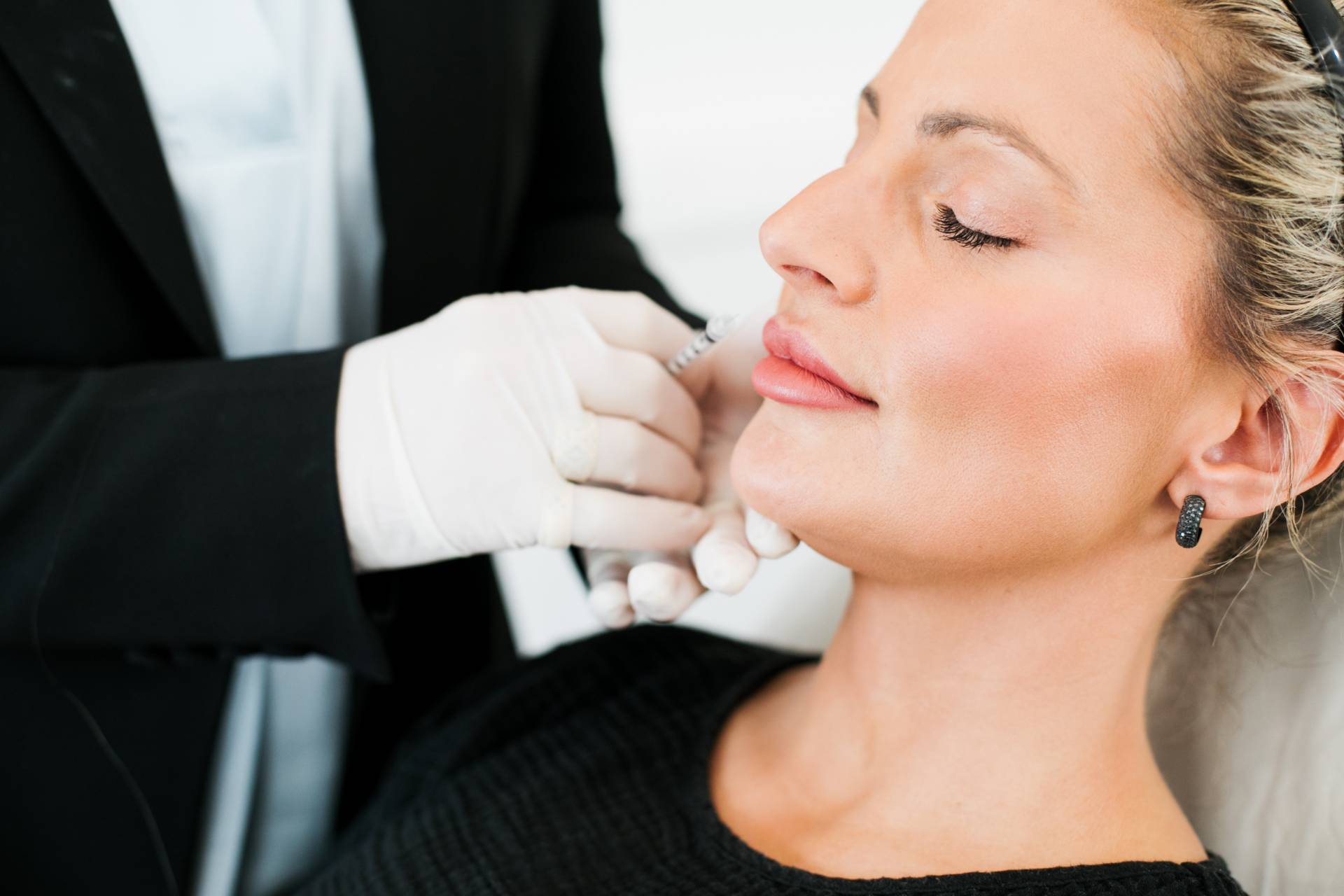Treatments
All About Injectables
What are cosmetic injectables?
There are two main types of injectable treatments, anti-wrinkle to smooth out lines and wrinkles and dermal filler to help restore loss of volume in the face.
1. Anti-wrinkle injections
Anti-wrinkle injections, are now one of the most popular cosmetic procedures performed in Australia.
How do they work?
Anti-wrinkle injections are a purified protein derivative of a bacterial toxin, called Botulinum Toxin A. When injected into muscles of facial expression, it has an effect on the neuromuscular junction (the area where nerves and muscles communicate) and blocks transmission of nerve signals to muscles, which in turn causes muscle relaxation.
Over time, repeated facial movements can cause wrinkles and expression lines to develop and deepen. By relaxing the muscles causing facial expression lines and reducing their movement, this can remove or reduce the appearance of existing wrinkles, depending on how deep they are, and can also prevent new ones from developing.
Who benefits from anti-wrinkle injections?
Everyone’s skin ages differently depending on factors like genetics, stress, smoking, alcohol consumption and sun exposure, so people of all ages can benefit from anti-ageing injections. People in their twenties and thirties can use them to slow the ageing process and prevent wrinkles, whilst those in their forties, fifties and above can receive treatment to reduce the appearance of deeper lines. It is important to note that once facial expression lines have become permanently etched into the skin, they can only be softened by anti-wrinkle injections, so it is good to start treatment with anti-wrinkle injections before lines become too deep.
What areas does it work on?
The most commonly treated areas include the the frown and the forehead. Many people also treat their Crows Feet, the smile lines around the eyes, and lines around the mouth and lip area. The chin, jawline and neck can also be treated, which is known as a Nefertiti Lift. Some people also benefit from injections into the armpit to help with excessive sweating.
When will I see a change and how long will it last?
Anti-wrinkle injections may start working in one to two days, but generally it takes two weeks to see the full effect of a treatment. In most instances, your practitioner will assess your results after two weeks, and occasionally a top up dose will be required. Your skin will appear tighter and smoother, and wrinkles will appear less pronounced or may disappear completely. The effects usually last around 3-4 months, depending on the dosage and the individual.

2. Dermal Fillers
How do they work?
Dermal fillers, are known as “temporary fillers” and are made up of a type of gel called hyaluronic acid gel. Hyaluronic acid is a component of the deeper layers of skin and joint capsules. The hyaluronic gel fillers are injected into or under the skin to smooth out lines and create a “plumper” appearance. There are also some dermal fillers that are hydrating and rejuvenating (known as “skin boosters”) that improve tissue quality.
There are also other types of dermal fillers known as a biostimulators which stimulate the body to produce more of its own collagen. They are injected into the skin in a similar way to dermal fillers, but should only be used by more experienced practitioners as their effects are longer lasting and not easily reversible.
Where can dermal fillers be used?
Most people are aware that dermal fillers can be used to plump lips, but they also have many other uses.
They can be used to treat:
- fine lines such as those around the lips
- deeper lines like nasolabial folds (the lines extending from the side of the nose to the corner of the mouth) and marionette lines (the lines extending down from the corners of the mouth).
- loss of volume that occurs as part of the ageing process. The typical areas that this occurs are the under eye hollow, (tear trough) the cheeks, the forehead and the temples.
- enhancing the contour of the jawline , the shape of the nose and the projection and shape of the chin.
- improving skin quality and the treatment of acne scars.
Who is suitable for dermal fillers?
Dermal fillers can be used in most age groups, and are suitable for both men and women.
Younger patients (must be over 18yo) often like to have their lips enhanced. People in their mid to late 20s and 30s may start to notice some facial volume loss and some fine lines, which can be an early sign of the ageing process. In this age group we can restore areas of lost volume, enhance the cheek bone area, and address fine lines.
Patients in their late 30s and 40s will have more advanced signs of volume loss, such as sagging along the jaw line and around the mouth, and may be developing deeper lines.
Clients in their 50s, 60s and even 70s and beyond can benefit from dermal fillers. Depending on the extent of volume loss and the depth of lines and wrinkles, the amount of filler required will vary from person to person.
How long do they last?
Typically dermal fillers last six to eighteen months, depending on the site injected and the type of filler used. The longevity of fillers in some areas can be improved by combining filler treatments with anti-wrinkle injections. The area we most commonly do this is when treating lip lines around the mouth.
Common problems with injectables:
While most injectables are generally very safe when administered properly, it is not unusual to experience side effects like redness, mild swelling, and bruising. These are usually self-limiting and settle very quickly.
Anti-wrinkle injections are generally very safe, although occasionally unwanted muscle relaxation may occur in an adjacent muscle causing either a droopy eyebrow or eyelid. This is usually only short-lived, and rarely lasts more than 4-6 weeks. In the case of a drooping brow-an injection under the brow will often lift it again. In the case of a drooping eyelid, there are drops which can reverse this side effect. Happily, these unwanted effects are very rare.
Dermal fillers, however, can have more serious side effects, as they can be inadvertently injected into a blood vessel and cause a blockage. Red flags for a complication such as this are severe pain in the area injected, blackening of the skin, blistering of the skin, or even loss of vision. In this situation, immediate medical attention is required to reverse the effect of the filler. This is achieved with injection of an enzyme called hyaluronidase that rapidly breaks down the filler. It is important that any clinic doing dermal filler injections has hyaluronidase available, and staff are trained how to recognise complications and use hyaluronidase appropriately.
Where are injectables available and why is this important?
As well as in medical centres and doctors’ offices, you can get injectables at beauty therapy clinics, hotels, spas, and even parties.
You need to have a medical degree to purchase injectables as they are Schedule 4 medications, that is they need to be prescribed by a doctor. They can however be administered by a registered nurse as long as it is under the supervision of a doctor. Legally, we are also not allowed to use the trade names of the common injectable treatments, again because they are Schedule 4 medications. Ideally, you should have a comprehensive medical assessment performed before embarking on an injectable treatment, and have a treatment plan formulated that is tailored to your specific concerns.
Unfortunately in many beauty therapy and chain laser clinics, there are no doctors on site, and the injectables are “prescribed” after a video or Skype consultation with a doctor. This is fine when the nurse is experienced and knows how to recognise and treat complications, but problems can arise when the injector is inexperienced and unable to manage and treat a complication quickly and appropriately to avoid a serious long-term issue. In some cases, these clinics use doctors who are in a remote location and not even in the same state, so they are not available to help out in the case of a problem.
It is also important to see a doctor or nurse who has a good grasp of facial aesthetics. They should understand appropriate facial balance and ideal beauty proportions so that they can achieve natural looking results which leave patients looking refreshed and rejuvenated, rather than over-filled or “frozen”.
Anti-ageing injections are more readily available than ever before, and are advertised at many beauty salons and even hairdressers and day spas. However, they are ultimately a medical procedure, so make sure you go to a reputable cosmetic or medical centre, and ask about the experience of your injector, and make sure they know how to handle or better still avoid any complications that may arise.


